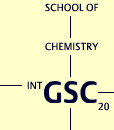 |


![]()
Name: Dr. Isabel Piel
Diploma / M.Sc degree: Westfälische Wilhelms-Universität Münster, Germany
(March 2008)
PhD Project: New concepts in modern catalysis
Homepage: http://www.uni-muenster.de/Chemie.oc/glorius/group/isabel_piel.html
Abstract of Research Project
Organocatalysis
The inversion of polarity (umpolung) of electrophilic substrates by addition of nucleophilic catalysts is a versatile and synthetically useful concept in organic chemistry.1 Furthermore, we believe that cooperativity of chemical systems will allow new and more efficient transformations, for example by tandem catalysis. The use of free N-heterocyclic carbenes (NHCs) as organocatalysts in the presence of transition-metal based catalysts is particularly challenging, since the ready formation of stable NHC-transition-metal complexes leads to a poisoning of both catalyst species.2

Scheme 1: General behavior of NHCs in the presence of transition metals.
C-H-functionalizations
As an alternative approach to transition-metal catalyzed cross-coupling reactions, C-H activations and related reactions revolutionize the way organic molecules are made and allow a more efficient use of earth’s natural resources. Despite the rapid progress of the last couple of years, many problems like limited scope, extreme reaction conditions or low reactivities and selectivities remain in many cases. C-H functionalizations often significantly streamline organic synthesis and decrease byproduct waste, therefore we strive to render C-H activations more practical by developing new synthetic strategies5 and apply these methods for the preparation of important classes of molecules.
References:
1. For excellent reviews on organocatalysis using NHCs, see: (a) N. Marion, S. Díez-.Gonzaález, S. P. Nolan, Angew. Chem. Int. Ed. 2007, 46, 2988.; (b) D. Enders, O. Niemeier, A. Henseler, Chem. Rev. 2007, 107, 5606; (c) D. Enders, T. Balensiefer, Acc. Chem. Res. 2004, 37, 534.
2. For applications of NHCs as ligands in catalysis, see: (a) N-Heterocyclic Carbenes in Synthesis; S. P. Nolan, Ed.; Wiley-VCH: Weinheim, Germany, 2006. (b) N-Heterocyclic Carbenes in Transition Metal Catalysis; F. Glorius, Ed.; Topics in Organometallic Chemistry,Vol 21; Springer: Berlin, 2007.
3. For other examples of compatibility of NHC with transition-metals, see: (a) T. Nemoto,
T. Fukuda,Y. Hamada, Tetrahedron Lett. 2006, 47, 4365-4368.
4. R. Lebeuf, K. Hirano, F. Glorius, Org. Lett. 2008, 10, 4243.
5. C. Wang, I. Piel, F. Glorius, J. Am. Chem. Soc. 2009, asap; DOI: 10.1021/ja8100598.
Publications
I. Piel, M. D. Pawelczyk, K. Hirano, R. Fröhlich, F. Glorius
A Family of Thiazolium Salt Derived N-Heterocyclic Carbenes (NHCs) for Organocatalysis: Synthesis, Investigation and Application in Cross-Benzoin Condensation
Eur. J. Org. Chem (2011), 5475-5484.
K. Hirano, I. Piel, F. Glorius
Dual Activation in NHC-Organocatalysis
Chem. Lett. 40 (2011), 786-791.
I. Piel, M. Steinmetz, K. Hirano, R. Fröhlich, S. Grimme, F. Glorius
Hoch asymmetrische NHC-katalysierte Hydroacylierung nichtaktivierter Alkene
Angew. Chem. 123 (2011), 5087–5091.
K. Hirano, A. T. Biju, I. Piel, F. Glorius
N-Heterocyclic Carbene-Catalyzed Hydroacylation of Unactivated Double Bonds
J. Am. Chem. Soc. 131 (2009), 14190-14191.
C. Wang, I. Piel, F. Glorius
Palladium-catalyzed Intramolecular Direct Arylation of Benzoic Acids by Tandem Decarboxylation/C-H Activation
J. Am. Chem. Soc. 131 (2009), 4194-4195.
Isabel Piel
eMail: Isabel Piel